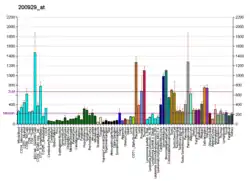TMED10
Transmembrane emp24 domain-containing protein 10 is a protein that in humans is encoded by the TMED10 gene.[4][5][6]
This gene is a member of the EMP24/GP25L/p24 family and encodes a protein with a GOLD domain. This type I membrane protein is localized to the plasma membrane and golgi cisternae and is involved in vesicular protein trafficking. The protein is also a member of a heteromeric secretase complex and regulates the complex's gamma-secretase activity without affecting its epsilon-secretase activity. Mutations in this gene have been associated with early-onset familial Alzheimer's disease. This gene has a pseudogene on chromosome 8.[6]
References
- GRCh38: Ensembl release 89: ENSG00000170348 - Ensembl, May 2017
- "Human PubMed Reference:". National Center for Biotechnology Information, U.S. National Library of Medicine.
- "Mouse PubMed Reference:". National Center for Biotechnology Information, U.S. National Library of Medicine.
- Sherrington R, Rogaev EI, Liang Y, Rogaeva EA, Levesque G, Ikeda M, Chi H, Lin C, Li G, Holman K, et al. (Aug 1995). "Cloning of a gene bearing missense mutations in early-onset familial Alzheimer's disease". Nature. 375 (6534): 754–60. doi:10.1038/375754a0. PMID 7596406.
- Blum R, Feick P, Puype M, Vandekerckhove J, Klengel R, Nastainczyk W, Schulz I (Sep 1996). "Tmp21 and p24A, two type I proteins enriched in pancreatic microsomal membranes, are members of a protein family involved in vesicular trafficking". J Biol Chem. 271 (29): 17183–9. doi:10.1074/jbc.271.29.17183. PMID 8663407.
- "Entrez Gene: TMED10 transmembrane emp24-like trafficking protein 10 (yeast)".
Further reading
- Maruyama K, Sugano S (1994). "Oligo-capping: a simple method to replace the cap structure of eukaryotic mRNAs with oligoribonucleotides". Gene. 138 (1–2): 171–4. doi:10.1016/0378-1119(94)90802-8. PMID 8125298.
- Suzuki Y, Yoshitomo-Nakagawa K, Maruyama K, et al. (1997). "Construction and characterization of a full length-enriched and a 5'-end-enriched cDNA library". Gene. 200 (1–2): 149–56. doi:10.1016/S0378-1119(97)00411-3. PMID 9373149.
- Gommel D, Orci L, Emig EM, et al. (1999). "p24 and p23, the major transmembrane proteins of COPI-coated transport vesicles, form hetero-oligomeric complexes and cycle between the organelles of the early secretory pathway". FEBS Lett. 447 (2–3): 179–85. doi:10.1016/S0014-5793(99)00246-X. PMID 10214941.
- Hörer J, Blum R, Feick P, et al. (1999). "A comparative study of rat and human Tmp21 (p23) reveals the pseudogene-like features of human Tmp21-II". DNA Seq. 10 (2): 121–6. doi:10.3109/10425179909008429. PMID 10376215.
- Wang H, Kazanietz MG (2002). "Chimaerins, novel non-protein kinase C phorbol ester receptors, associate with Tmp21-I (p23): evidence for a novel anchoring mechanism involving the chimaerin C1 domain". J. Biol. Chem. 277 (6): 4541–50. doi:10.1074/jbc.M107150200. PMID 11689559.
- Majoul I, Straub M, Hell SW, et al. (2001). "KDEL-cargo regulates interactions between proteins involved in COPI vesicle traffic: measurements in living cells using FRET". Dev. Cell. 1 (1): 139–53. doi:10.1016/S1534-5807(01)00004-1. PMID 11703931.
- Gommel DU, Memon AR, Heiss A, et al. (2002). "Recruitment to Golgi membranes of ADP-ribosylation factor 1 is mediated by the cytoplasmic domain of p23". EMBO J. 20 (23): 6751–60. doi:10.1093/emboj/20.23.6751. PMC 125325. PMID 11726511.
- Barr FA, Preisinger C, Kopajtich R, Körner R (2002). "Golgi matrix proteins interact with p24 cargo receptors and aid their efficient retention in the Golgi apparatus". J. Cell Biol. 155 (6): 885–91. doi:10.1083/jcb.200108102. PMC 2150891. PMID 11739402.
- Strausberg RL, Feingold EA, Grouse LH, et al. (2003). "Generation and initial analysis of more than 15,000 full-length human and mouse cDNA sequences". Proc. Natl. Acad. Sci. U.S.A. 99 (26): 16899–903. doi:10.1073/pnas.242603899. PMC 139241. PMID 12477932.
- Heilig R, Eckenberg R, Petit JL, et al. (2003). "The DNA sequence and analysis of human chromosome 14". Nature. 421 (6923): 601–7. doi:10.1038/nature01348. PMID 12508121.
- Ota T, Suzuki Y, Nishikawa T, et al. (2004). "Complete sequencing and characterization of 21,243 full-length human cDNAs". Nat. Genet. 36 (1): 40–5. doi:10.1038/ng1285. PMID 14702039.
- Brandenberger R, Wei H, Zhang S, et al. (2005). "Transcriptome characterization elucidates signaling networks that control human ES cell growth and differentiation". Nat. Biotechnol. 22 (6): 707–16. doi:10.1038/nbt971. PMID 15146197.
- Breuza L, Halbeisen R, Jenö P, et al. (2004). "Proteomics of endoplasmic reticulum-Golgi intermediate compartment (ERGIC) membranes from brefeldin A-treated HepG2 cells identifies ERGIC-32, a new cycling protein that interacts with human Erv46". J. Biol. Chem. 279 (45): 47242–53. doi:10.1074/jbc.M406644200. PMID 15308636.
- Gerhard DS, Wagner L, Feingold EA, et al. (2004). "The status, quality, and expansion of the NIH full-length cDNA project: the Mammalian Gene Collection (MGC)". Genome Res. 14 (10B): 2121–7. doi:10.1101/gr.2596504. PMC 528928. PMID 15489334.
- Chen F, Hasegawa H, Schmitt-Ulms G, et al. (2006). "TMP21 is a presenilin complex component that modulates gamma-secretase but not epsilon-secretase activity". Nature. 440 (7088): 1208–12. doi:10.1038/nature04667. PMID 16641999.
- Chi A, Valencia JC, Hu ZZ, et al. (2007). "Proteomic and bioinformatic characterization of the biogenesis and function of melanosomes". J. Proteome Res. 5 (11): 3135–44. doi:10.1021/pr060363j. PMID 17081065.
This article is issued from Wikipedia. The text is licensed under Creative Commons - Attribution - Sharealike. Additional terms may apply for the media files.



